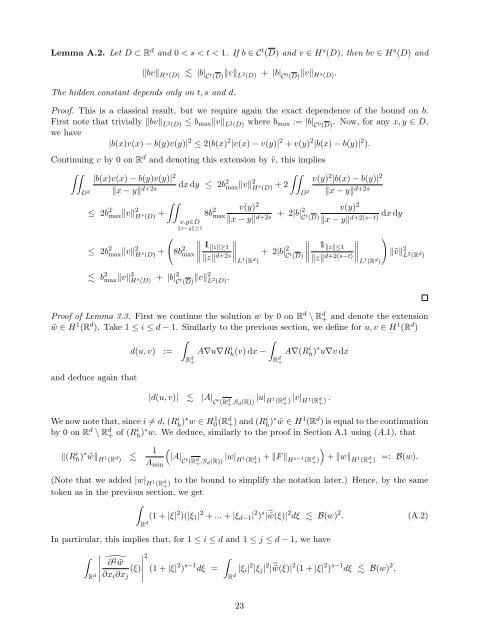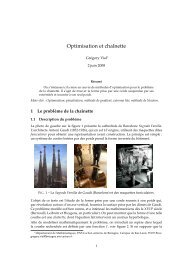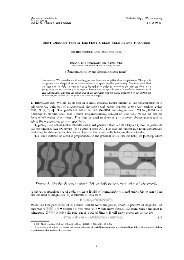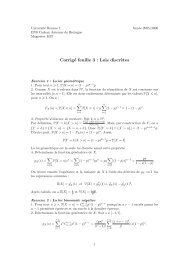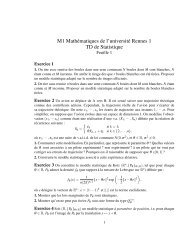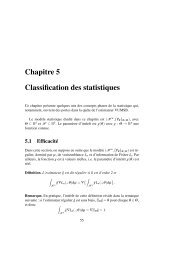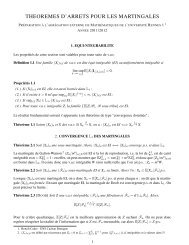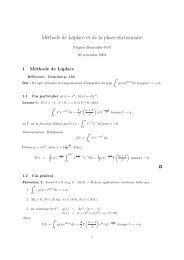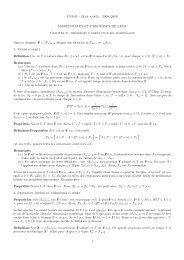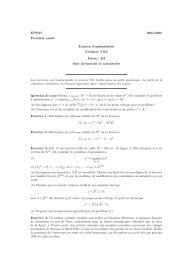Bath Institute For Complex Systems - ENS de Cachan - Antenne de ...
Bath Institute For Complex Systems - ENS de Cachan - Antenne de ...
Bath Institute For Complex Systems - ENS de Cachan - Antenne de ...
Create successful ePaper yourself
Turn your PDF publications into a flip-book with our unique Google optimized e-Paper software.
Lemma A.2. Let D ⊂ R d and 0 < s < t < 1. If b ∈ C t (D) and v ∈ H s (D), then bv ∈ H s (D) and‖bv‖ H s (D) |b| C t (D) ‖v‖ L 2 (D) + |b| C 0 (D) ‖v‖ H s (D).The hid<strong>de</strong>n constant <strong>de</strong>pends only on t, s and d.Proof. This is a classical result, but we require again the exact <strong>de</strong>pen<strong>de</strong>nce of the bound on b.First note that trivially ‖bv‖ L 2 (D) ≤ b max ‖v‖ L 2 (D) where b max := |b| C 0 (D). Now, for any x, y ∈ D,we have|b(x)v(x) − b(y)v(y)| 2 ≤ 2(b(x) 2 |v(x) − v(y)| 2 + v(y) 2 |b(x) − b(y)| 2 ).Continuing v by 0 on R d and <strong>de</strong>noting this extension by ṽ, this implies|b(x)v(x) − b(y)v(y)|∫∫D 2∫∫2 ‖x − y‖ d+2s dx dy ≤ 2b 2 max‖v‖ 2 H s (D) + 2 v(y) 2 |b(x) − b(y)| 2D 2 ‖x − y‖ d+2s∫∫≤ 2b 2 max‖v‖ 2 H s (D) + 8b 2 v(y) 2max‖x − y‖ d+2s + v(y) 22|b|2 dx dyC t (D)‖x − y‖ d+2(s−t)x,y∈D‖x−y‖≥1∥ ∥ )≤ 2b 2 max‖v‖ 2 H s (D)(8b + 2 1 ‖z‖≥1 ∥∥∥Lmax ∥‖z‖ d+2s + 2|b| 2 1 ‖z‖≤1 ∥∥∥LC t (D) ∥1 (R d ) ‖z‖ d+2(s−t) ‖ṽ‖ 2 L 2 (R d )1 (R d ) b 2 max‖v‖ 2 H s (D) + |b|2 C t (D) ‖v‖2 L 2 (D) .Proof of Lemma 3.3. First we continue the solution w by 0 on R d \ R d + and <strong>de</strong>note the extension˜w ∈ H 1 (R d ). Take 1 ≤ i ≤ d − 1. Similarly to the previous section, we <strong>de</strong>fine for u, v ∈ H 1 (R d )∫∫d(u, v) := A∇u∇Rh i (v) dx − A∇(Rh i )∗ u∇v dxand <strong>de</strong>duce again thatR d +R d +|d(u, v)| |A| C t (R d + ,S d(R)) |u| H 1 (R d + ) |v| H 1 (R d + ) .We now note that, since i ≠ d, (R i h )∗ w ∈ H 1 0 (Rd +) and (R i h )∗ ˜w ∈ H 1 (R d ) is equal to the continuationby 0 on R d \ R d + of (R i h )∗ w. We <strong>de</strong>duce, similarly to the proof in Section A.1 using (A.1), that‖(R i h )∗ ˜w‖ H 1 (R d )1()|A|A C t (R d min + ,S d(R)) |w| H 1 (R d + ) + ‖F ‖ H s−1 (R d + ) + ‖w‖ H 1 (R d + ) =: B(w).(Note that we ad<strong>de</strong>d |w| H 1 (R d + ) to the bound to simplify the notation later.) Hence, by the sametoken as in the previous section, we get∫(1 + |ξ| 2 )(|ξ 1 | 2 + ... + |ξ d−1 | 2 ) s |̂˜w(ξ)| 2 dξ B(w) 2 .(A.2)R dIn particular, this implies that, for 1 ≤ i ≤ d and 1 ≤ j ≤ d − 1, we have∫ ∣ ∣∣∣∣ ̂∂2 ˜w(ξ)R d ∂x i ∂x j ∣2(1 + |ξ| 2 ) s−1 dξ =∫R d |ξ i | 2 |ξ j | 2 |̂˜w(ξ)| 2 (1 + |ξ| 2 ) s−1 dξ B(w) 2 ,23


